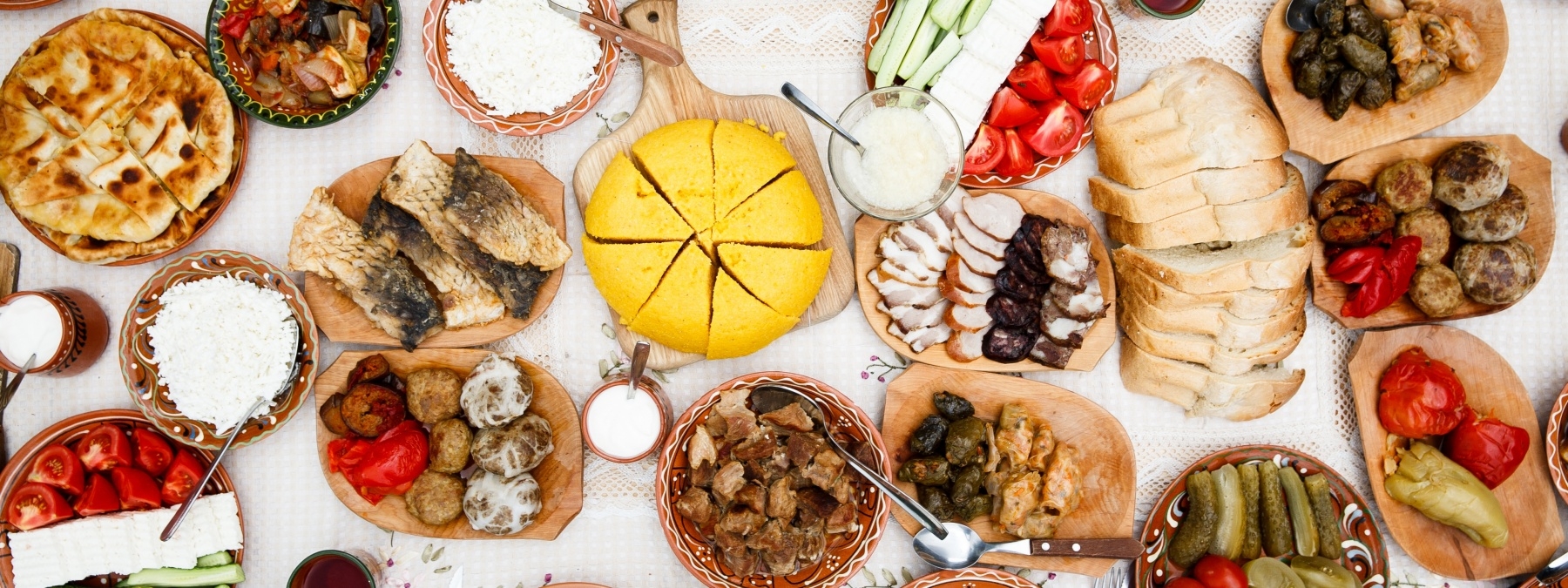Moldovan cuisine is sure to come to everyone’s liking: it is so various and rich that it becomes problematic to savour even one third of all known dishes. Abundance of fruit and vegetable, fertile pastures to breed cattle and poultry, ancient customs of dairy production – all the aforesaid and many other features have made the Moldovan cuisine unrepeatable.
Moldovan cuisine influenced a lot the traditional cuisines of other nations on its territory and in the same time enriched itself with elements from the Ukrainian, Bulgarian, Gagauz, Russian cuisines, and in previous centuries from the Greek and Turkish ones.
Traditionally, the residents of Moldova dine three times per day. It is a custom to serve a glassful of wine to dinner or supper meals which is either home-made or produced at a factory. As a rule, a meal of the Moldovans is composed of no less than two courses. While to celebrate anniversaries, baptising of children, marriages or other events, it is a custom to arrange festive tables with as much courses as possible, which are sometimes arranged in a cheque order in three layers. It is a custom in Moldova to welcome guests in “Casa Mare” (a separate room in a house to commemorate significant events which is not used in ordinary days), while serving nutritious meals and a glassof Moldovan wine. Apart of wine, tea and coffee is also popular in Moldova, together with dairy and sour-milk beverages, juices, stewed fruits and the like.
Dishes of Moldovan cuisine are served at restaurants and cafes. The distinctive feature, compared other countrie is that there is no division of restaurants “for tourists” and “for locals”. Most all restaurants serve home-like delicious dishes.
The most famous dishes in Moldova are mamaliga – an art of polenta with a fine delicious taste, the chicken soup called zeama, tocana and others. Traditional for local cuisine are the dishes prepared from various vegetables: tomatoes, sweet pepper, eggplant, white cabbage, beans, onion, garlic, leek etc. Vegetables are used to prepare salads and sauces; they are baked, sautéed, salted or marinated, obtaining thus real culinary pieces of arts. The specific feature of the national cuisine is given by the great variety of dishes prepared from corn or corn flour: grits, pastry, soups, flakes, nonalcoholic beverages, etc. Mamaliga is served with cracklings, roast meat, cheese, sour cream, etc.
A special role in the Moldovan cuisine is played by meat dishes, but also by entrees. Very popular are the chicken zeama, borsch, tocana, roast meat and pork cutlets, beef sausages, lamb mandzha. Many meat and fish dishes are grilled on fiery charcoal. Usually the dishes prepared this way would be previously marinated.
Not a single traditional holiday is possible without sarmale, racitura, pasta with chicken soup, etc. The festive table would be tastefully garnished with delicious dishes from wheat flour: pastry, placinta, saralia with fruits, vegetables, nuts, etc.
In different areas of Moldova local cuisine is the dominant one: in the eastern regions the Ukrainians prefer the famous borsch, in the south Bulgarians will serve you the traditional sauce – chicken mandzha, and the Gagauz – shourpa, a lamb meat soup, cooked with lots of spices, in Russian communities the pelmeny are popular, etc.
In Moldovan cuisine a broad variety of traditional beverages is served: compotes, fruit juices, but also strong drinks, as wine, divines, brandy, home-brandy, etc. The wine making in Moldova has secular traditions. The famous Moldovan wines are known and appreciated abroad. They can be dry, dessert or fortified wines, can have a varied bouquet of aromas and chromatic nuances. For the preparation of wines both European and Moldovan sorts are used: Feteasca Alba, Feteasca Regala, Feteasca Neagra, Rara Neagra, etc.
Meals we advise you to order:
*Mamaliga (dense maize porridge) with various dressing or supplements as brinza (cow, goat or sheep cheese), sour-cream, cottage cheese, butter, fried pork trimmings, tocana (stewed pork), fried fish with mujdei (garlic sauce).
*Sarmale (cabbage rolls) - rice wrapped in leaves of cabbage or grape (it may also be cooked using leaves of maple, coltsfoot, horse-reddish and the like) with meat and vegetable stuffing (the dish may be cooked for lent without meat).
*Grill dishes (baked in coals rather popular in Moldova) – mititei and mici (cutlets made ofminced meat in form of sausages), carnatei (sausage of sliced meat), barbeque (pork, beef, mutton, chicken and the like), grilled vegetables (egg-plants, sweet pepper, tomatoes).
*Zama (chicken soup with home-made noodles).
*Ciorba (bean soup with or without meat).
*Ghiveci (stewed vegetables) and chopped eggplants
*Brinza.
*Placinte or invartite (pie or moldavian layer pie) (rolls made of thin doughwith various stuffing, mainly with brinza, cottage cheese, cubage, cherry).
*Dried plumps stuffed with nuts in cream sauce.
